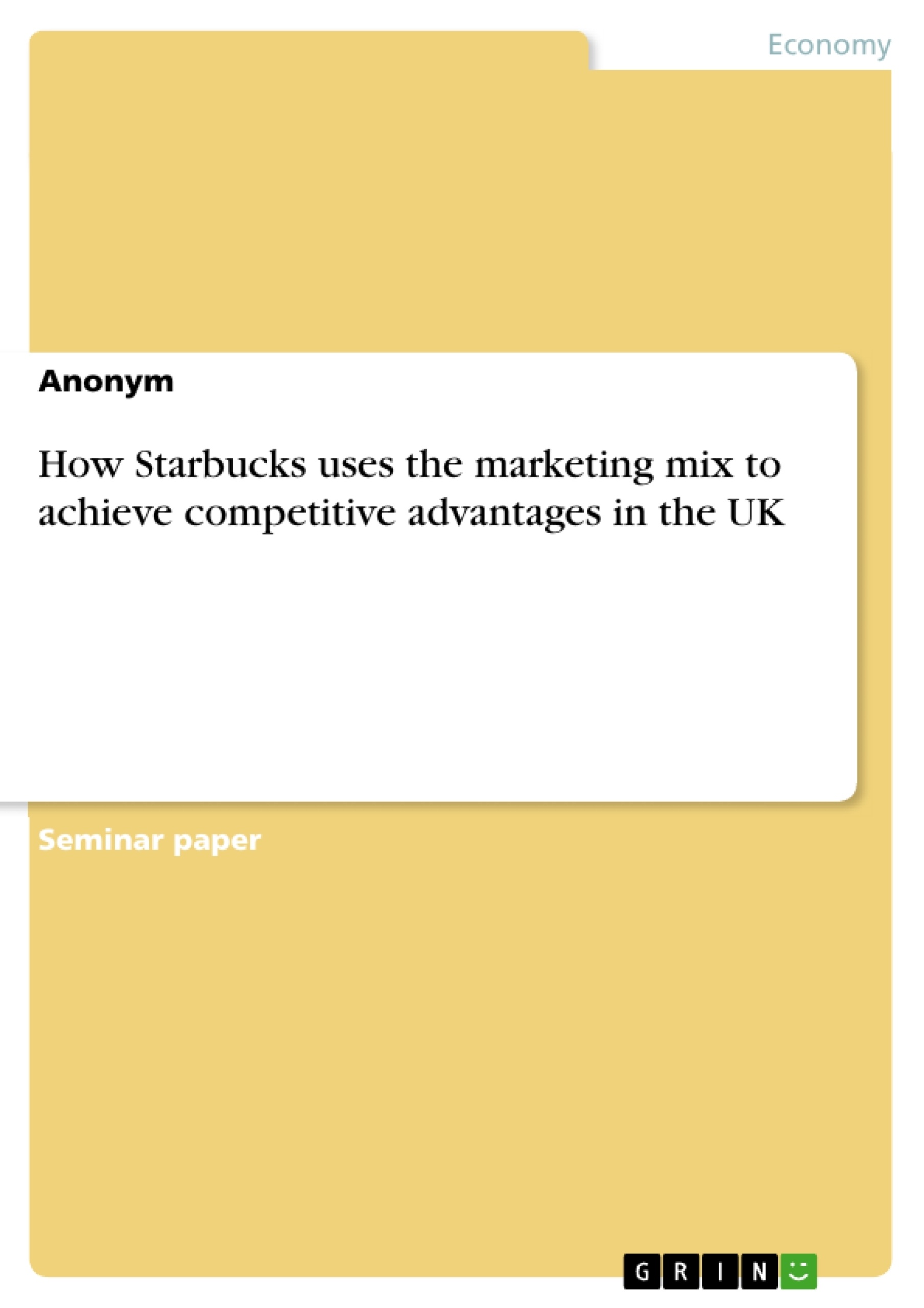The aim of this paper is to analyse the way in which each element of Starbucks’ marketing mix contributes to achieve sustainable competitive advantage in the UK market. In order to identify critical success factors, marketing elements will be examined and contrasted to competitors’ approaches.
Ever since the first coffee houses were opened in the late fourteen hundreds, they have been a gathering place for people to socialise and discuss business. Today, the possibilities of how and where to enjoy a cup of coffee are plentiful and Starbucks aims to set itself apart from other coffee houses by creating an experience around coffee, which caters to people’s lifestyles. As a supplier of high-quality coffee, Starbucks has become one of the most recognised brands worldwide. The company’s approach to doing business and its impressive success story set it apart from other companies and make it an interesting case for analysing retail marketing strategies.
Table of Contents
- Introduction
- Position in the Market
- Internationalisation Strategy
- Market Overview
- Target Segments
- Positioning
- Competitive Strategy
- Marketing Mix
- Product
- Brand
- CSR
- Customer Service
- Quality
- Product Range
- Health Trend
- Brand
- Price
- Customers' Value Equation
- Place
- Location
- Store Format
- Convenience
- Distribution Channels
- Promotion
- Renaissance Plan
- In-Store Communication
- Relationship Marketing
- My Starbucks Rewards
- Social Media
- My Starbucks Idea
- People
- Employee Satisfaction
- Employee Appearance
- Physical Evidence
- Store Layout
- Store Environment
- Product
- Starbucks' marketing mix strategy in the UK.
- Competitive advantage in the UK coffee market.
- Critical success factors for Starbucks in the UK.
- The creation of a unique customer experience.
- Branding and brand recognition in the coffee industry.
- Introduction: This chapter introduces the paper's aim, which is to analyze how Starbucks' marketing mix contributes to sustainable competitive advantage in the UK market. It provides a brief overview of the history of coffee houses and highlights Starbucks' positioning as a brand that creates an experience around coffee.
- Position in the Market: This chapter delves into Starbucks' position within the UK market. It examines the competitive landscape and analyzes Starbucks' strengths and weaknesses compared to its competitors. This chapter likely explores factors like market share, brand image, and customer demographics.
- Internationalisation Strategy: This chapter examines Starbucks' strategy for expanding its presence in the UK market. It could cover topics like entry strategies, market adaptation, and cultural considerations. The chapter might analyze the challenges and opportunities of internationalizing a coffee brand.
- Market Overview: This chapter likely provides a detailed analysis of the UK coffee market. It may include information on market size, growth trends, consumer preferences, and competitive dynamics. The chapter aims to establish a comprehensive understanding of the market context in which Starbucks operates.
- Target Segments: This chapter focuses on the specific customer groups that Starbucks targets in the UK. It could examine demographics, psychographics, and consumer behavior, providing insight into who Starbucks aims to reach with its marketing efforts.
- Positioning: This chapter examines how Starbucks positions itself within the UK coffee market. It may analyze the brand's value proposition, key differentiators, and positioning map. The chapter aims to understand how Starbucks distinguishes itself from its competitors and what its unique selling proposition is.
- Competitive Strategy: This chapter analyzes Starbucks' competitive strategy in the UK market. It might discuss Porter's Five Forces model, competitive advantage frameworks, or specific strategies employed by Starbucks to maintain its market position. The chapter explores how Starbucks interacts with competitors and defends its market share.
- Marketing Mix: This chapter provides a comprehensive analysis of Starbucks' marketing mix, covering the following elements:
- Product: This section explores Starbucks' product offerings, including brand image, customer service, quality, and product range. It likely discusses the "Starbucks experience" and its impact on customer satisfaction.
- Price: This section analyzes Starbucks' pricing strategy, taking into account customer perception, value equation, and competitive pricing. It might examine pricing variations across different products and promotions.
- Place: This section focuses on the physical distribution of Starbucks products, including location, store format, convenience, and distribution channels. It may explore the strategic selection of store locations and the role of online ordering and delivery.
- Promotion: This section delves into Starbucks' promotional activities, including the Renaissance Plan, in-store communication, and relationship marketing initiatives like My Starbucks Rewards and social media campaigns. It explores how Starbucks communicates its brand message to target customers.
- People: This section analyzes the human resources aspect of Starbucks' marketing strategy, focusing on employee satisfaction, training, and appearance. It explores how employee engagement contributes to the overall customer experience.
- Physical Evidence: This section examines the tangible aspects of Starbucks' brand, including store layout, environment, and ambiance. It explores how these elements contribute to creating a welcoming and memorable customer experience.
Objectives and Key Themes
This paper examines Starbucks' marketing mix strategy in the UK, aiming to understand how each element contributes to achieving sustainable competitive advantage. By analyzing and contrasting Starbucks' approach to competitors, the paper identifies critical success factors in the UK market.Chapter Summaries
Keywords
This paper analyzes Starbucks' marketing mix strategy, focusing on achieving sustainable competitive advantage in the UK market. Key themes include the creation of a unique customer experience, the impact of brand image and recognition, and the effective utilization of various marketing mix elements to achieve market dominance. The paper examines competitive strategies, target segments, and the role of various communication channels in building brand loyalty.- Quote paper
- Anonym (Author), 2012, How Starbucks uses the marketing mix to achieve competitive advantages in the UK, Munich, GRIN Verlag, https://www.grin.com/document/284888




